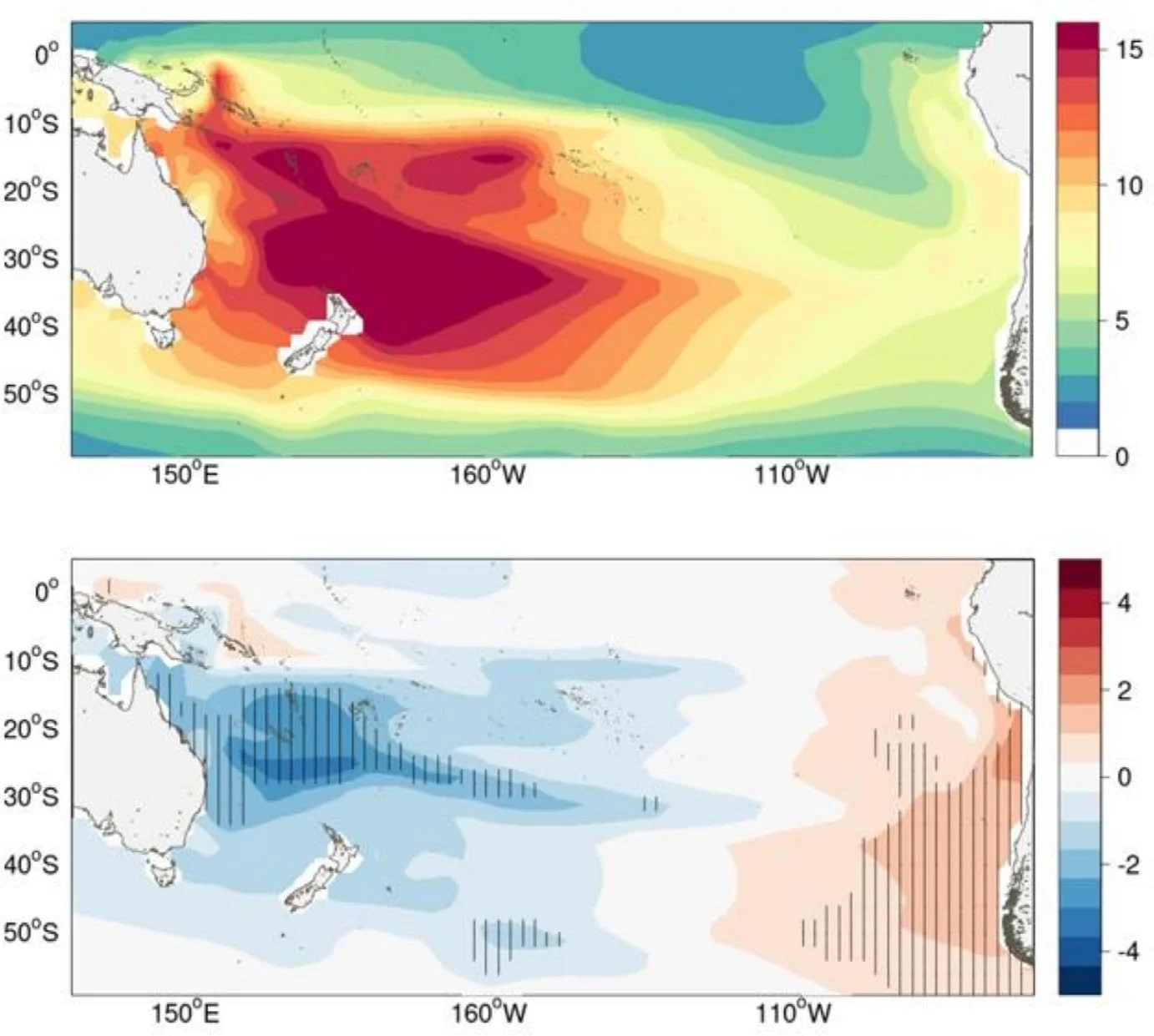My experience in writing collaborative papers is somewhat limited, typically involving 4-5 co-authors at a time, and that requires time and coordination. I have no idea what it would take to get 22 people involved, but I guess I’m lucky to know half of them, so I would ask one day.
This interesting Ghothi paper*, Putting Regional Fisheries Management Organisations' Climate Change House in Order, examines the urgent need for Regional Fisheries Management Organisations (RFMOs) to adapt their scientific processes to address the impacts of climate change on transboundary fish stocks.
Using South Pacific albacore tuna (SPA) as a case study, the authors demonstrate how climate change is affecting the biology, abundance, and distribution of fish stocks, creating challenges for sustainable fisheries management.
Projected effects of climate change on the distribution of South Pacific albacore tuna (SPA). Average biomass distribution (kg.km−2) of SPA in the Southern Pacific Ocean basin for 2015 (2011–2020) (top), and mean anomalies (kg.km−2) from the average 2015 biomass distribution projected to occur by 2050 (2044–2053) under the RCP 8.5 emissions scenario (bottom)
The paper identifies four key research areas to assist RFMOs in enhancing their scientific frameworks and maintaining the resilience of fisheries in the face of climate change.
Enhancing Understanding of Biological Changes: Climate change affects key biological factors, including growth, fecundity, and migration patterns, of fish stocks. Current stock assessment models often assume that these factors remain constant over time, which is unlikely under changing environmental conditions. The paper emphasises the importance of including climate-induced changes within research frameworks. For SPA, studies have indicated variations in life history across its range, highlighting the need for further analysis of its spatial stock structure. Techniques like Close-Kin Mark-Recapture (CKMR) are recommended for estimating population variables, such as connectivity, abundance, and fecundity, which are vital for effective management.
Enhancing Data Collection. Robust data collection is crucial for detecting shifts in biological and environmental factors. The paper advocates for long-term data collection programmes that combine fishery-dependent and fishery-independent data. Collaborating with fishing fleets and leveraging advanced technologies, such as temperature sensors on longline gear, can improve data quality and reduce costs. Initiatives like these have already demonstrated success, as evidenced by a 40% improvement in thermocline depth estimates in New Zealand. The authors also emphasise the importance of coordinated biological sampling networks in supporting advanced modelling techniques.
Improving CPUE Modelling: Catch-per-unit-effort (CPUE) data is a key indicator of fish stock abundance, but it must be refined to account for climate-induced changes in fish distribution and fleet dynamics. The paper recommends adopting advanced modelling techniques, such as generalised additive models (GAMs), machine learning methods, and spatiotemporal approaches, to improve the reliability of CPUE indices. For SPA, incorporating habitat suitability variables and three-dimensional ecosystem data (e.g., depth distribution) into CPUE models is crucial for better reflecting the impacts of climate change on stock assessments.
Ensuring Adaptive and Robust Scientific Advice: Fisheries management must adapt to the uncertainties brought by climate change. The paper differentiates between adaptive strategies, which involve flexible management measures, and robust strategies, designed to perform well under high levels of uncertainty. Management strategy evaluation (MSE) is recommended to test harvest strategies against different climate scenarios. For SPA, strategies that consider spatial biomass redistribution caused by ocean warming are emphasised as essential. The authors also highlight the importance of dynamic depletion-based benchmarks, which may be more resilient to climate-driven changes in recruitment dynamics.
The paper concludes that RFMOs must invest in these four research areas to ensure the sustainable management of transboundary fish stocks in the face of climate change. Collaborative efforts between RFMOs, member countries, and fishing fleets are essential to improve data collection, modelling, and management strategies. By adopting robust and adaptable scientific advice, RFMOs can better tackle the challenges posed by ocean warming and secure the long-term sustainability of fisheries. The SPA case study serves as a model for other RFMOs managing stocks affected by climate change.
* Ghoti papers: Ghoti aims to serve as a forum for stimulating and pertinent ideas. Ghoti publishes succinct commentary and opinion that addresses important areas in fish and fisheries science. Ghoti contributions will be innovative and have a perspective that may lead to fresh and productive insight of concepts, issues and research agendas. All Ghoti contributions will be selected by the editors and peer reviewed.
Etymology of Ghoti: George Bernard Shaw (1856–1950), polymath, playwright, Nobel prize winner, and the most prolific letter writer in history, was an advocate of English spelling reform. He was reportedly fond of pointing out its absurdities by proving that ‘fish’ could be spelt ‘ghoti’. That is: ‘gh’ as in ‘rough’, ‘o’ as in ‘women’ and ‘ti’ as in palatial.
